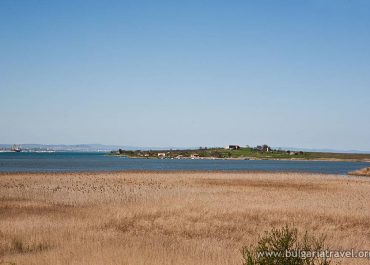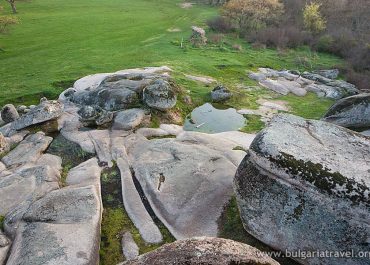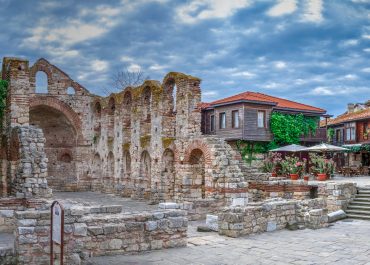
Roman town of Deultum, village of Debelt
The village of Debelt is situated 17 km south-west from Burgas. The name of the contemporary village of Debelt is a modification of the name of the antique town Deultum and the medieval Develt, the remains of which are located at the end of the village. The Roman Colony of Deultum was established here at the beginning of the 70s of the 1st century, during the ruling of emperor Tit Flavius Vespasian, by the veterans of the 8th Augustan Legion. This is the only colony of free roman citizens on the present Bulgarian territory. There was a port by the town, which was situated by the present Mandrensko Lake.
In the following three centuries the town broadened and established itself as one of the richest towns in the province. During the ruling of Emperor Mark Aurelius (2nd century AD) it was protected by large fortified walls. The town structure is according to the Hippodamus system (a rectangular street network-oriented according to the globe directions), with a very good water supply and sewerage. Impressive baths with floor heating were found during archaeological excavations. It was built at the end of the 1st century and reconstructed during the following centuries to the end of the 3rd century. The building size, as well as the degree to which it is preserved, are impressive.
The moving of the capital of the Roman Empire from Rome to Constantinople in the 4th century had a great influence on the town development. It turned into an element of the defense system of the empire against barbarian raids and an important communication point.
The first rectangular fortification with an area of 5,000 square meters was constructed around the middle of the 4th century. It was not only covering the roman settlement, but also the upper part of the hill behind it. The east town gate, from which the main street begins, also dates back to this period. The Slavs also initiated raids during the second half of the 6th century.
In 812 Khan Krum conquered Develt and banished the local residents to the north of the Danube river. On their place he settled Bulgarians, and Develt turned into Bulgarian settlement.
During the early Middle Ages, the town became an important border point between Bulgaria and Byzantium.
The rising of the level of the Black Sea in the 13th – 14th century led to gradual swamping of the plain around the firth. The port moved to the east in the direction of the contemporary Burgas Bay. Life in the town declined, and after the 14th century, the name of the settlement is no longer seen in the historical sources.
A number of large coin treasures were found during archaeological examinations in the region. Statues, inscriptions, ceramics and small finds have also been found here. They can be seen nowadays in the Archaeological Museum in the city of Burgas. The fortress was declared an architectural and constructional monument in Issue 65 of the State Gazette of 1965.
You can learn more about the fortress in the Archaeological Base in the village of Debelt. There you can purchase information materials and souvenirs. Deultum was declared one of the Bulgarian Wonders in 2011, selected by electronic voting.
One can reach the village of Debelt by second-grade road A-77 from Burgas to Sredets. There are board signs before the road turn for the village.
Tourist information center Burgas- “South Bus Station”
Working hours: Monday-Sunday, 10:00-18:00
Queen Joanna Square
Tel: +359 56 59 89 43
Tourist information center Burgas – “The Clock”
Monday-Sunday 10:00 – 18:00
8000 Burgas, 37 “Aleksandrovska” str. /at the corner of “Alexandrovroska” Str. and “Aleko Bogoridi” Blvd./
Tel: +359 56 825 772
E-mail: info@gotoburgas.com
Website: http://gotoburgas.com/bg
Telephone for information: +359 888 506 816
Archaeological Base in the village of Debelt
Village of Debelt, 3 Georgi Dimitrov Str.
Monday – Friday 8:00 – 5:00
on Saturday and Sunday – upon a preliminary request
E-mail: deultum@mail.bg
The village of Debelt is situated 17 km south-west from Burgas. The name of the contemporary village of Debelt is a modification of the name of the antique town Deultum and the medieval Develt, the remains of which are located at the end of the village. The Roman Colony of Deultum was established here at the beginning of the 70s of the 1st century, during the ruling of emperor Tit Flavius Vespasian, by the veterans of the 8th Augustan Legion. This is the only colony of free roman citizens on the present Bulgarian territory. There was a port by the town, which was situated by the present Mandrensko Lake.
In the following three centuries the town broadened and established itself as one of the richest towns in the province. During the ruling of Emperor Mark Aurelius (2nd century AD) it was protected by large fortified walls. The town structure is according to the Hippodamus system (a rectangular street network-oriented according to the globe directions), with a very good water supply and sewerage. Impressive baths with floor heating were found during archaeological excavations. It was built at the end of the 1st century and reconstructed during the following centuries to the end of the 3rd century. The building size, as well as the degree to which it is preserved, are impressive.
The moving of the capital of the Roman Empire from Rome to Constantinople in the 4th century had a great influence on the town development. It turned into an element of the defense system of the empire against barbarian raids and an important communication point.
The first rectangular fortification with an area of 5,000 square meters was constructed around the middle of the 4th century. It was not only covering the roman settlement, but also the upper part of the hill behind it. The east town gate, from which the main street begins, also dates back to this period. The Slavs also initiated raids during the second half of the 6th century.
In 812 Khan Krum conquered Develt and banished the local residents to the north of the Danube river. On their place he settled Bulgarians, and Develt turned into Bulgarian settlement.
During the early Middle Ages, the town became an important border point between Bulgaria and Byzantium.
The rising of the level of the Black Sea in the 13th – 14th century led to gradual swamping of the plain around the firth. The port moved to the east in the direction of the contemporary Burgas Bay. Life in the town declined, and after the 14th century, the name of the settlement is no longer seen in the historical sources.
A number of large coin treasures were found during archaeological examinations in the region. Statues, inscriptions, ceramics and small finds have also been found here. They can be seen nowadays in the Archaeological Museum in the city of Burgas. The fortress was declared an architectural and constructional monument in Issue 65 of the State Gazette of 1965.
You can learn more about the fortress in the Archaeological Base in the village of Debelt. There you can purchase information materials and souvenirs. Deultum was declared one of the Bulgarian Wonders in 2011, selected by electronic voting.
One can reach the village of Debelt by second-grade road A-77 from Burgas to Sredets. There are board signs before the road turn for the village.
Tourist information center Burgas- “South Bus Station”
Working hours: Monday-Sunday, 10:00-18:00
Queen Joanna Square
Tel: +359 56 59 89 43
Tourist information center Burgas – “The Clock”
Monday-Sunday 10:00 – 18:00
8000 Burgas, 37 “Aleksandrovska” str. /at the corner of “Alexandrovroska” Str. and “Aleko Bogoridi” Blvd./
Tel: +359 56 825 772
E-mail: info@gotoburgas.com
Website: http://gotoburgas.com/bg
Telephone for information: +359 888 506 816
Archaeological Base in the village of Debelt
Village of Debelt, 3 Georgi Dimitrov Str.
Monday – Friday 8:00 – 5:00
on Saturday and Sunday – upon a preliminary request
E-mail: deultum@mail.bg
Virtual map
Photos
© All images, advertising and video materials and/or other information published on this website are property of the Ministry of Tourism and are protected by the Law on Copyright and Related Rights, according to the Bulgarian laws to all applicable international and relevant acts of the European Union.





